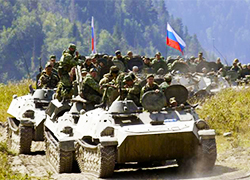The New York Times: Russia may invade Ukraine without warning
31- 5.08.2014, 11:51
- 45,671

Russia has doubled the number of its battalions near the Ukrainian border.
Russia could respond to the Kiev government’s gains there by launching a cross-border incursion with little or no warning, the New York Times' Michael R. Gordon and Eric Schmitt write.
The Kremlin’s intentions remain unclear. “President Vladimir V. Putin of Russia could be seeking to pressure Ukraine and the United States to agree to a political settlement that would grant the eastern provinces of Ukraine maximum autonomy. But Mr. Putin, Western officials fear, may also be developing the option to intervene more directly if it appears that the pro-Russian separatists in Ukraine are on the verge of defeat.”
According to the newspaper's diplomatic sources, the intervention may be held under the guise of a “peacekeeping operation.” “That’s a very real option,” a senior Defense Department official said on Monday. “And should Putin decide, he could do that with little or no notice. We just don’t know what he’s thinking.”
The authors of the article note that both the Kremlin and the West respond to the standoff over Ukraine by turning to the tools they know best. “For President Obama and European leaders, the tool is calibrated economic sanctions, targeted to affect banks close to the Kremlin or narrow subsectors of the Russian economy, like Russia’s long-term ability to develop new Arctic, deep sea and shale oil reserves. But for Mr. Putin, the tool is the Kremlin’s ability to marshal raw military power and, increasingly, its willingness to use it,” the write.
“He has set the military and political conditions for what he believes could be a successful intervention,” General Clark, the retired general and former NATO commander, said. “But he still doesn’t seem to have made the political decision to do this, perhaps because he recognizes that the risks after an intervention are incalculable.”
Phillip A. Karber, a former adviser to Defense Secretary Caspar W. Weinberger, also thinks Russia's action may take a form of a “peacekeeping operation”. In a closed-door briefing for Congress last month, Mr. Karber noted that Russian military vehicles bearing the Russian emblem for peacekeeping forces had been positioned close to Ukraine.
Strikingly, the White House has been taking the idea of a Russian “peacekeeping” intervention seriously. “We’ve seen a significant rebuild up of Russian forces along the border, potentially positioning Russia for a so-called humanitarian or peacekeeping intervention in Ukraine,” Antony J. Blinken, the deputy national security adviser to Mr. Obama, said last week when the White House announced new sanctions. “So there’s urgency to arresting this.”
American and NATO officials have not publicly provided precise troop estimates for the Russian forces near Ukraine. Last week, Pentagon officials put the total at 10,000 to 13,000 troops, but they acknowledged the difficulty of counting Russian troops with precision.
As charter97.org reported earlier, a train carrying self-propelled mortars arrived in Belarus from Russia on August 2. The train with tens of units of military equipment was noticed by city residents on the railway.
Photo from the archive








